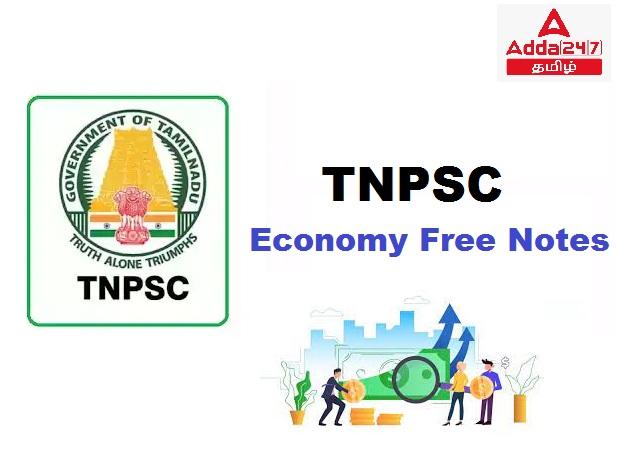இந்தக் கட்டுரையில், TNPSC குரூப் 1, குரூப் 2, குரூப் 2A, குரூப் 4 மாநிலப் போட்டித் தேர்வுகளான TNUSRB, TRB, TET, TNEB போன்றவற்றுக்கான முறைகள் இலவசக் குறிப்புகளைப் பெறுவீர்கள்.தேர்வுக்கு தயாராவோர் இங்குள்ள பாடக்குறிப்புகளை படித்து பயன்பெற வாழ்த்துகிறோம்.
Fiscal Economics
Introduction
The term ‘Fiscal Economics’ is a new one, the old and popular term of the subject is
‘Public Finance’.
The term fiscal is derived from Greek word which means basket and symbolizes the
public purse.
Public Finance studies the manner in which the state raises and spends the resources.
Meaning of Public Finance
The Public Finance is related to the financing of the State activities and it discusses the
financial operations of the Government treasury.
Public finance is a study of the financial aspects of Government. It is concerned with the
revenue and expenditure of the public authorities and with adjustment of the one to the
other.
Definitions
“Public finance is one of those subjects that lie on the border line between Economics
and Politics. It is concerned with income and expenditure of public authorities and with
the adjustment of one to the other”.
-Huge Dalton
“Public finance is an investigation into the nature and principles of the state revenue
and expenditure”.
-Adam Smith
Subject Matter / Scope of Public Finance
In Modern times, the subject ‘Public Finance’ includes five major sub-divisions.
They are Public Revenue, Public Expenditure, Public Debt, Financial Administration and
Fiscal Policy.
Public Revenue
Public revenue deals with the methods of raising public revenue such as tax and non-
tax, the principles of taxation, rates of taxation, impact, incidence and shifting of taxes
and their effects.
Public Expenditure
This part deals with the fundamental principles that govern the Government
expenditure, effects of public expenditure and control of public expenditure.
Public Debt
Public debt deals with the methods of raising loans from internal and external
sources.
The burden, effects and redemption of public debt fall under this head.
Financial Administration
This part deals with the study of the different aspects of public budget.
The budget is the Annual master financial plan of the Government.
The various objectives and steps in preparing a public budget, passing or
sanctioning, allocation evaluation and auditing fall within financial administration.
Fiscal Policy
Taxes, subsidies, public debt and public expenditure are the instruments of fiscal policy.
Public finance and Private finance
Public finance deals with study of income, expenditure, borrowing and financial
administration of the government.
Private finance is the study of income, expenditure, borrowing and financial
administration of individual or private companies.
Both public and private finance are fundamentally similar in nature but different
from each other on various operational aspects.
Similarities
1. Rationality
Both public finance and private finance are based on rationality.
Maximization of welfare and least cost factor combination underlie both.
2. Limit to borrowing
Both have to apply restraint with regard to borrowing.
The Government also cannot live beyond its means. There is a limit to deficit
financing by the state also.
3. Resource utilisation
Both the private and public sectors have limited resources at their disposal.
So both attempt to make optimum use of resources.
4. Administration
The effectiveness of measures of the Government as well as private depends on the
administrative machinery.
If the administrative machinery is inefficient and corrupt it will result in wastages
and losses.
Dissimilarities
1. Income and Expenditure adjustment
The government adjusts the income to the expenditure.
The individuals adjust their expenditure to the income.
Private finance involves stitching coat according to cloth available whereas public
finance decides the cloth according to the need for the coat.
2. Borrowing
The government can borrow from internal and external sources; it can borrow from the
people by issuing bonds. However, an individual cannot borrow from himself.
3. Right to print currency
The government can print currency.
This involves the creation, distribution and monitoring of currency.
The private sector cannot create currency.
4. Present vs. Future decisions
The public finance is more involved with future planning and making long-
term decisions.
These investments could include building of schools, hospitals and
infrastructure.
The private finance makes financial decisions on projects with a short-term
vision.
5. Objective
The public sector’s main objective is to provide social benefit in the economy.
The private sector aims to maximize personal benefit i.e. Profit.
6. Coercion to get revenue
The sources of income of a private individual are relatively limited while those of the
Government is wide.
The Government can use its power and authority.
7. Ability to make huge and deliberate changes
The public finance has the ability to make big decisions on income.
For example, it can effectively and deliberately adjust the revenue.
But individuals cannot make such massive decisions.
**************************************************************************
| Adda247 TamilNadu Home page | Click here |
| Official Website=Adda247 | Click here |









